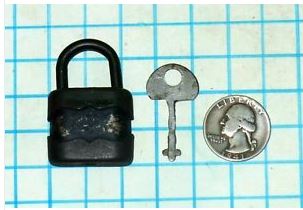Warded locks are very simple devices. At the far end of the lock is a catch or spring. Rotation of the end of the key releases this. Between this mechanism and the keyhole is a space with a number of cross-walls or “wards”. The key cannot turn unless its cut-out sections coincide with the position of the wards. With a little forethought keys can be designed that will only open certain locks in a house, but not others. The downside is that warded locks only really prevent the use of other keys. If most of the excess metal of a key is removed the result is a key that can open a warded lock irrespective of the pattern of wards. This is the original meaning of “skeleton key”. Items such as screwdrivers might be modified to open some locks.
Warded mechanisms are still used and a set of skeleton keys can be purchased or fabricated with modest effort or expenditure. Such keys are, however, too large for the small warded locks commonly encountered on luggage.
While still common, such locks have dubious value. Many can easily be snapped open, sometimes without the need for tools. These, and many other luggage locks, can be bypassed by items such as pens applied to the zipper.
The keys for such small warded locks do not exhibit much variation. Some locks don’t even have any warding inside! I have a key on my bunch from a lock I have not seen for decades. When I encountered a small warded lock recently I tried the key and it opened the lock like they had been made for each other. Below is the lock, the key that opened it and a skeleton key for small warded locks that I made.
Some of your lock picking tools might open a small warded lock. I have opened such a lock using hooks, half-diamonds, single-hump Bogotas and snowmen. A ball or half-ball would probably work too. Just insert the pick and rotate until you trip the latch or spring.
Conventional lock picks are not really designed to take lateral pressure, so such use should be occasional or for when you do not have a better alternative. If you are a customs officer or someone else who often has a legitimate need to regularly open such locks you can make yourself an opener from some stout wire, tube or rod. Below is a photo of one of my turning tools. The rod section of the handle has been given a slight hook for opening small warded locks.
Alternately, the creation of a small skeleton key should be relatively simple, particularly if you already have a similar key. Keys can also be formed from scrap metal. The skeleton key that I made was created from a section of laboratory spatula. It was produced in under three minutes using just pliers and a needle file. This now rides the same ring as my other skeleton keys.
If you have enjoyed this article or it has been helpful to you please feel free to show your appreciation. Thank you.The Books















